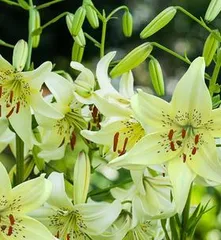Lily flowers are beautiful and elegant flowers, widely used in gardens and for indoor decoration. However, to make them grow strong and bloom abundantly, it is necessary to choose the right planting time, soil, and environmental conditions. This article will introduce planting and care techniques for lily flowers.

Choosing the Right Month
Lily flowers are suitable for planting in spring or autumn, with the best time being in spring, usually in March or April. At this time, the temperature gradually warms up and the soil starts to warm up, which is conducive to the growth of lilies. Autumn is also a good choice, around September or October.
Choosing the Right Soil Type
Lily flowers are suitable for planting in soil rich in organic matter, and the soil's pH value should be between 6.0-7.0. In addition, good drainage and ventilation are also very important, otherwise it will affect the health and growth of the plant.

Ensuring Adequate Sunlight
Lily flowers need sufficient sunlight, so choose to plant them in a sunny place, preferably a south-facing location. If planted in a place that is too shady, it will affect the plant's growth and flowering.
Maintaining a Suitable Temperature
The most suitable temperature for lily flowers to grow is between 20-25 degrees Celsius. Temperatures that are too high or too low will affect the growth and flowering of the flowers. In summer, direct exposure to the sun should be avoided, while in winter, ensure the indoor temperature is within a suitable range.
Watering Timely
Lily flowers need an appropriate amount of water to maintain normal growth and metabolic activities, but not too much, as it can easily lead to root rot. Usually, watering once a week is sufficient. Pay attention to avoid watering on the flower buds.

Strengthening Fertilization
Lily flowers are a type of flower that likes fertilizer and should be fertilized in spring and autumn each year. You can choose some organic or chemical fertilizers, and avoid excessive use to prevent damage to the flowers.
Pruning Branches and Leaves Timely
The branches and leaves of lily flowers grow very fast and need to be pruned in time to maintain the plant's shape and healthy state. You can do shaping pruning after the flowering period, cutting off withered leaves and flower stems, and keeping the healthy parts.
Controlling Pests and Diseases
Lily flowers are susceptible to pests and diseases, so timely prevention and treatment are necessary. You can choose some safe and effective pesticides and adjust the dosage according to the pest and disease situation.
Strengthening Protective Measures
When encountering abnormal weather or climate changes, it is necessary to strengthen the protective measures for lily flowers to avoid suffering from natural disasters such as wind, rain, and snow. You can use tools like sunshade nets and rain shelters for protection.
Transplanting Plants Rationally
If lily flowers grow too fast or are too dense, they need to be transplanted to ensure the plant's growth environment and nutrient supply. When transplanting, pay attention to protecting the roots, and water and fertilize appropriately after transplanting.
Weeding Timely
Lily flowers grow very fast and can easily be covered by surrounding weeds, so timely weeding is necessary to maintain the health and beauty of the plant.
Preventing Overwatering
Lily flowers are susceptible to the effects of overwatering, which can lead to problems such as root hypoxia and root rot. When watering, pay attention to the appropriate amount to avoid waterlogging and excessive moisture.
Observing Flowers Carefully
During the growth period of lily flowers, it is necessary to often observe the growth and flowering of the flowers to discover and deal with abnormal situations in time, ensuring the health and beauty of the plant.
Rational Use of Pruning
After lilies bloom, you can use pruning for propagation or to change the shape. Cutting off branches and leaves can promote the growth and branching of the plant.
Lily flowers are beautiful and elegant flowers, but to make them grow healthy and bloom abundantly, it is necessary to choose suitable soil, maintenance environment, and care techniques. It is hoped that this article will be helpful to everyone in the planting and care of lily flowers.